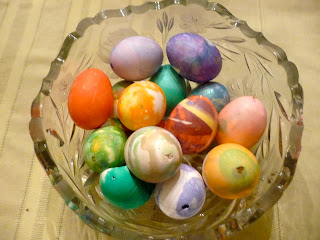Before we completely abandon the Easter theme--
Last week in our World Religion class, we made eggs inspired by the Ukrainian technique of decorating eggs called Pysanky. The traditional art of Pysanky is kind of like batik on eggs; that is, the artists uses wax to over up the parts of the egg they want to keep the existing color, then dip the eggs into increasingly dark dyes. So, for example, they first cover up what they want to remain white, then dip the egg into yellow dye. Next they apply more wax to the areas they want to keep yellow (without removing the wax on the white areas), and then dip the egg in the next darkest color (usually orange or light pink). This continues until the eggs have been dyed their darkest colors, usually dark blue, purple, or black. After they have dried completely, the artist uses heat to remove the wax, revealing the multi-colored designs the wax have protected over multiple dying cycles. They can end up being really fabulous.
Obviously, this is a long and involved process that doesn't fit well into a limited class time. So we kind of faked our way through it by using masking tape instead of wax. We couldn't get the fine lines of true Pysanky, and with the number of people we had and our time constraints, the students couldn't dip them in too many colors. But it did give them the idea of how it worked so they could explore it more at home.
But more than simply a craft activity, we also discussed things related to Easter as we dyed our eggs. For example, I asked them what the life and/or death of Jesus had to do with eggs. They came up with lots of creative ideas, but then I let them know the answer--nothing, really. Dying Easter eggs, such as Pysanky, is a hold-over tradition from pagan times. In the case of the Ukranians, for example, eggs became sacred symbols and talismans because the ancient people worshiped birds because they could fly up to speak with the Sun God, which was their highest diety. So decorating eggs became part of their spring solstice celebration known in English as Ostara (which is where the word Easter came from). Because in these celebrations, the eggs were used as a symbol for spring and the rebirth of the Earth, when the Christians came along, they allowed the pagans to continue their old traditions, but just tried to convince them that the rebirth was not of the Earth, but of Jesus. It was techniques like these--assimilating pre-existing rituals rather than trying to eradicate them--that helped Christianity spread through so many different cultures to become the largest religion in the world today.
However, I also encouraged the student to think of the multiple dying cycles as representing the many different types of trials that Jesus went through during Holy Week, or the last week of his normal human life on Earth. That is, obviously the focus is on his physical death by crucifiction. But also during that week, he had to suffer doubts and abandonment (his friends fell asleep during his final hours of freedom), betrayal and denial by his disciples, false claims and judgements by both religious and political authorities, rejection by the masses who had acclaimed his entrance into Jeruselum only days before, physical torture, and attempts to mock and humiliate him. His ability to retain his faith and his dignity, and even to forgive those who participated in all these trials, are inspiring lessons in themselves, regardless of what religious beliefs you have about truth and/or meaning of the crucifixion and resurrection.
Anyway, we had a good discussion and created some pretty eggs, even in our rushed and limited situation. Here are some of the eggs we made:














No comments:
Post a Comment